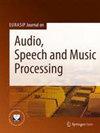Automatic classification of the physical surface in sound uroflowmetry using machine learning methods
IF 1.9
3区 计算机科学
Q2 ACOUSTICS
Eurasip Journal on Audio Speech and Music Processing
Pub Date : 2024-02-16
DOI:10.1186/s13636-024-00332-y
引用次数: 0
Abstract
This work constitutes the first approach for automatically classifying the surface that the voiding flow impacts in non-invasive sound uroflowmetry tests using machine learning. Often, the voiding flow impacts the toilet walls (traditionally made of ceramic) instead of the water in the toilet. This may cause a reduction in the strength of the recorded audio signal, leading to a decrease in the amplitude of the extracted envelope. As a result, just from analysing the envelope, it is impossible to tell if that reduction in the envelope amplitude is due to a reduction in the voiding flow or an impact on the toilet wall. In this work, we study the classification of sound uroflowmetry data in male subjects depending on the surface that the urine impacts within the toilet: the three classes are water, ceramic and silence (where silence refers to an interruption of the voiding flow). We explore three frequency bands to study the feasibility of removing the human-speech band (below 8 kHz) to preserve user privacy. Regarding the classification task, three machine learning algorithms were evaluated: the support vector machine, random forest and k-nearest neighbours. These algorithms obtained accuracies of 96%, 99.46% and 99.05%, respectively. The algorithms were trained on a novel dataset consisting of audio signals recorded in four standard Spanish toilets. The dataset consists of 6481 1-s audio signals labelled as silence, voiding on ceramics and voiding on water. The obtained results represent a step forward in evaluating sound uroflowmetry tests without requiring patients to always aim the voiding flow at the water. We open the door for future studies that attempt to estimate the flow parameters and reconstruct the signal envelope based on the surface that the urine hits in the toilet.利用机器学习方法对声波尿流测量中的物理表面进行自动分类
这项研究首次利用机器学习技术对无创声尿流测量测试中的排泄流冲击表面进行自动分类。通常情况下,排泄流冲击的是马桶壁(传统上由陶瓷制成),而不是马桶内的水。这可能会导致记录的音频信号强度降低,从而导致提取的包络线振幅减小。因此,仅通过分析包络线,无法判断包络线振幅的减小是由于排空流量的减小还是由于对厕所墙壁的影响。在这项工作中,我们研究了男性受试者尿流声测量数据的分类,具体取决于尿液在马桶内撞击的表面:三个类别分别是水、陶瓷和静音(静音指排泄流中断)。我们探索了三个频段,研究去除人声频段(8 kHz 以下)以保护用户隐私的可行性。在分类任务方面,我们评估了三种机器学习算法:支持向量机、随机森林和 k 近邻。这些算法的准确率分别为 96%、99.46% 和 99.05%。这些算法是在一个新的数据集上进行训练的,该数据集由在四个标准西班牙语厕所中录制的音频信号组成。该数据集由 6481 个 1 秒音频信号组成,分别标记为安静、在陶瓷上排空和在水上排空。所获得的结果标志着在评估声音尿流测量测试方面向前迈进了一步,而无需要求患者始终将排尿流量对准水。我们为未来的研究敞开了大门,这些研究试图根据厕所中尿液接触的表面来估算尿流参数和重建信号包络。
本文章由计算机程序翻译,如有差异,请以英文原文为准。
求助全文
约1分钟内获得全文
求助全文
来源期刊

Eurasip Journal on Audio Speech and Music Processing
ACOUSTICS-ENGINEERING, ELECTRICAL & ELECTRONIC
CiteScore
4.10
自引率
4.20%
发文量
0
审稿时长
12 months
期刊介绍:
The aim of “EURASIP Journal on Audio, Speech, and Music Processing” is to bring together researchers, scientists and engineers working on the theory and applications of the processing of various audio signals, with a specific focus on speech and music. EURASIP Journal on Audio, Speech, and Music Processing will be an interdisciplinary journal for the dissemination of all basic and applied aspects of speech communication and audio processes.
 求助内容:
求助内容: 应助结果提醒方式:
应助结果提醒方式:


